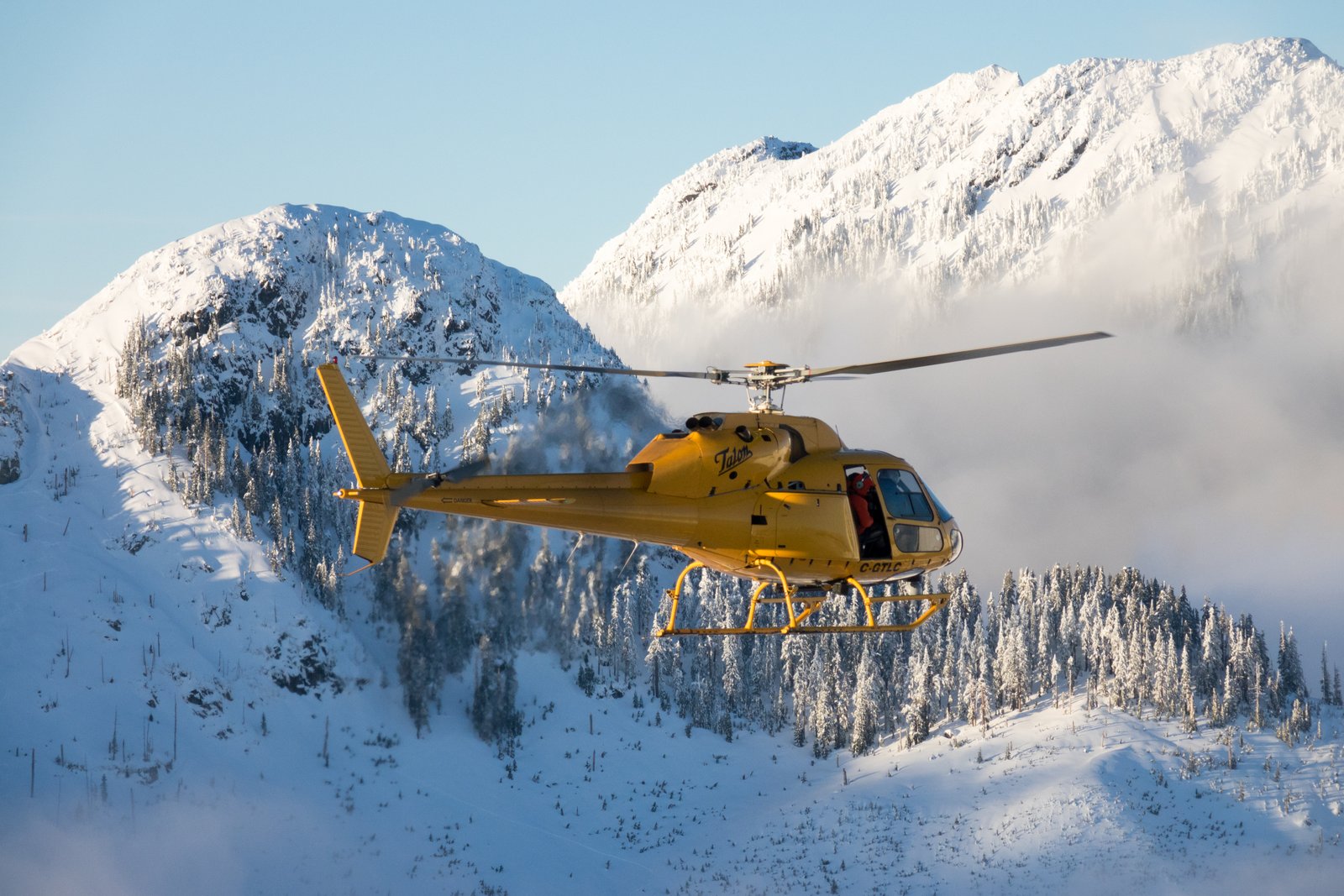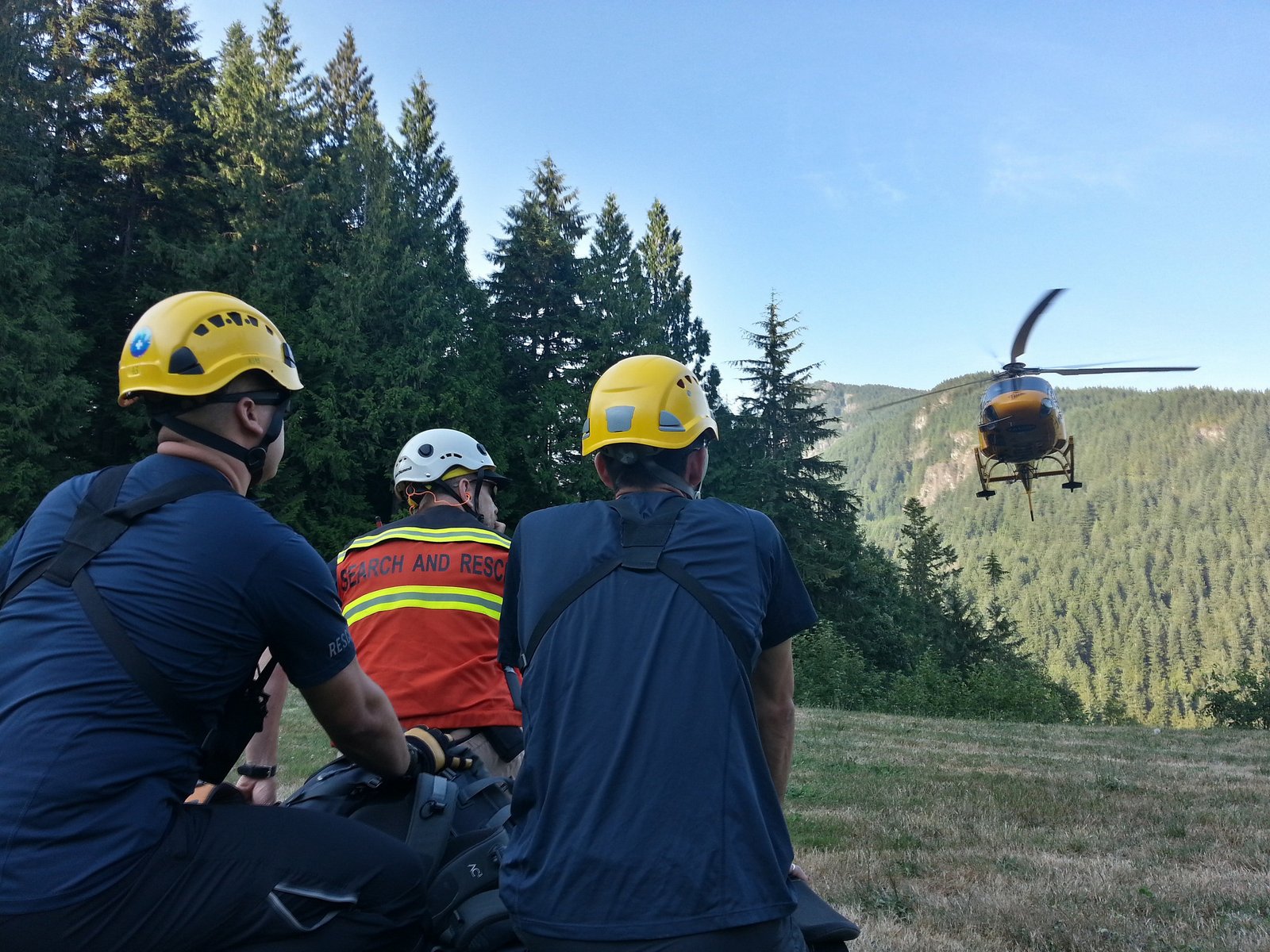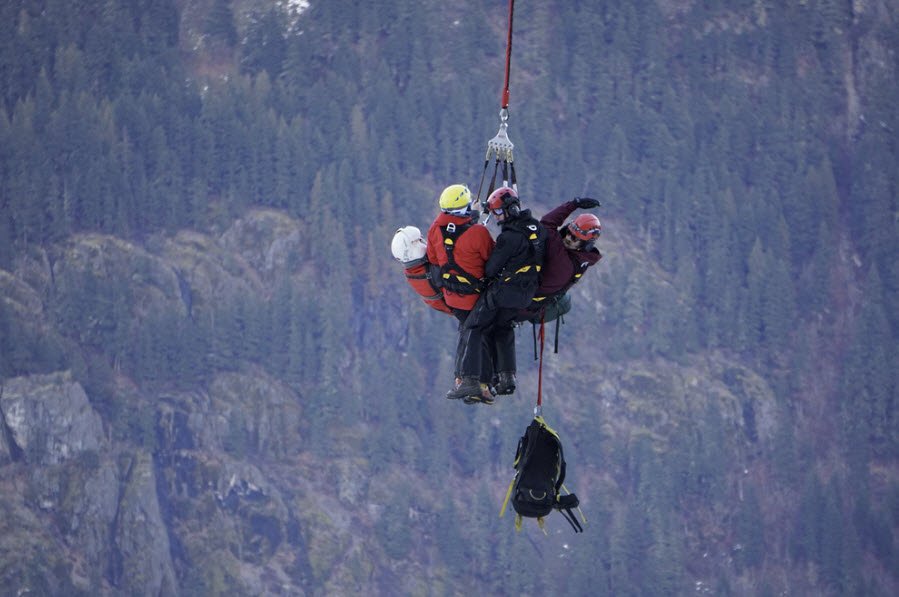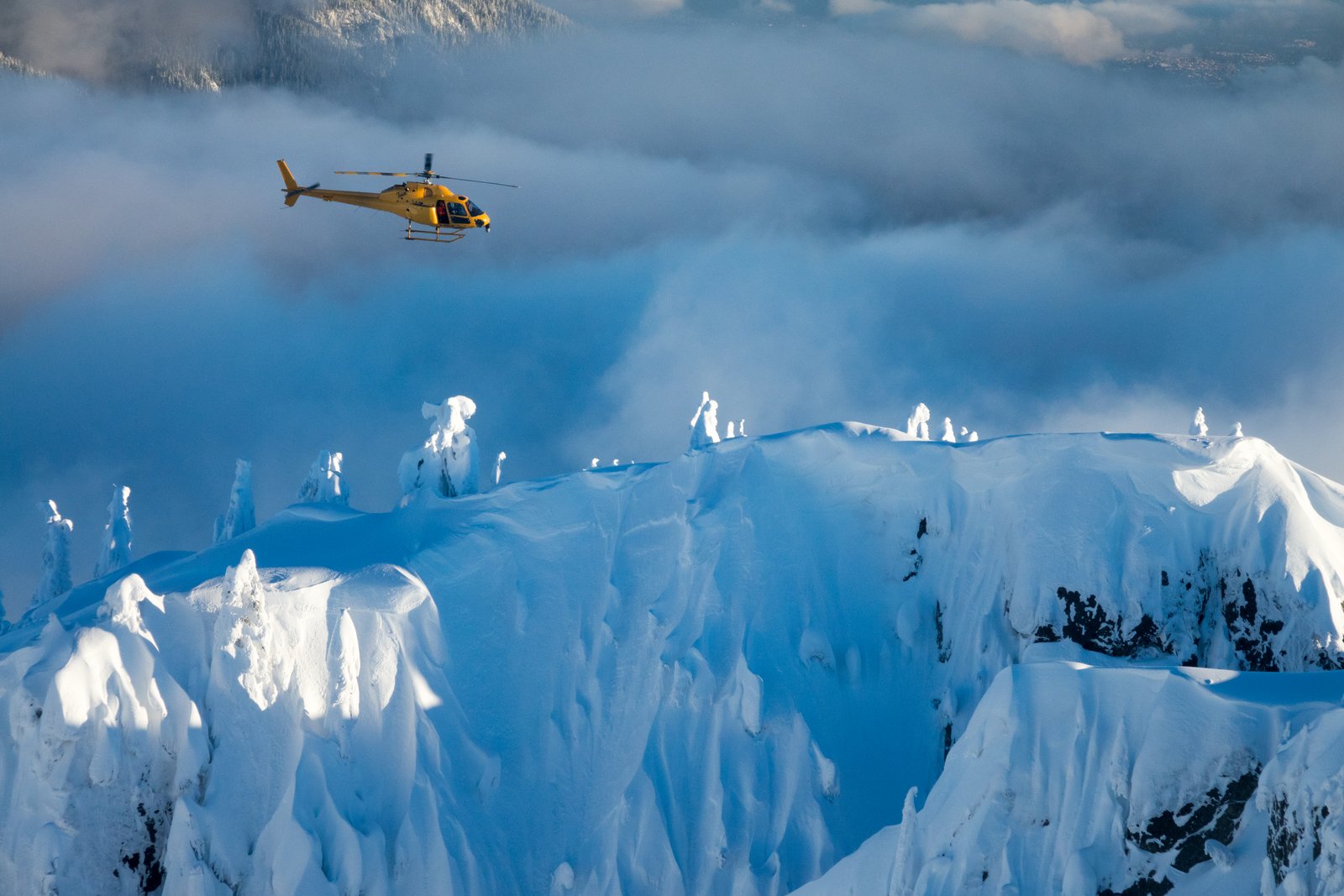Written for Skies Magazine – March/April 2017
Tune into the TV news in Vancouver, and one might see a story about a hapless hiker who’s lost in the local mountains, or a senseless snowboarder who rode out-of-bounds into a ravine. Invariably, to get the story, the reporter interviews one of the back-country rescue specialists at North Shore Rescue (NSR), with a bright yellow helicopter belonging to Vancouver-based Talon Helicopters hovering in the background.
If the rescue is successful, the video might show people dangling on a long-line below Talon’s TwinStar helicopter as they drop gently into a parking lot. Sometimes, though, the rescue becomes a recovery mission. And in the 20-year relationship between NSR and Talon, rescue specialists and pilots have seen their share of both.
Helicopters weren’t always part of NSR’s resources, according to team leader Mike Danks. Interestingly, the all-volunteer organization was originally established in 1965 as an urban search and rescue team that would have assisted Civil Defence in Vancouver, had the Cold War become hot. Fortunately, the team was never called upon to fulfil its original mandate, and the focus shifted to providing search and rescue (SAR) services in the North Shore Mountains overlooking Vancouver.
“They didn’t use aircraft [then] like we do today,” said Danks. “Sometimes, they’d be out for days searching for people, and then hiking them out in a stretcher, over land, in some pretty extreme circumstances.”
A second-generation member of NSR, Danks has been on the team for 20 years. “My dad was a member of NSR back in the ‘70s. I always went out for training with them, and I’d be the dummy in the stretcher,” he remembered with a chuckle.
The training and time commitment expected of NSR members is substantial. Even before being considered for the rigorous two-year Member-in-Training program, applicants must have a high level of physical fitness and extensive local back-country knowledge and skills, including hiking, snow-shoeing, and climbing. A five-year commitment is expected, and since volunteers could be called for a rescue mission at any time, they must have an understanding with their employer.
NSR doesn’t charge any fee for rescues, and covers its operating expenses through fundraising, donations, sponsorships and government grants. Costs related to specific resources, such as helicopter flight time, are covered by Emergency Management BC, a provincial government agency.
“We’re typically busier in the summer with medical rescues,” said Danks. “Our yearly average has been 90 to 100 calls, but since 2013 that number has drastically risen. In 2016, we had 132 calls. It’s almost become a trendy thing to do. If you go hiking in the local mountains on a beautiful day, it’s not uncommon to see hundreds of people in the back-country.”
But some of those people are not even remotely prepared for the outdoors. Danks said he’s seen so-called hikers out in business suits and dress shoes, and women wearing high heels. Common sense seems to elude other would-be enthusiasts, with the vast majority of calls coming from hikers who hadn’t considered that having a flashlight after dark is a good idea.
“A group of nine people hiked for a couple of hours to St. Mark’s Summit, which has gorgeous sunset views,” recalled Danks. “They enjoyed a beautiful sunset, and then figured out that nobody had a flashlight! They had a cell signal, so we put a crew in, brought them some lights, and hiked them out.”
The majority of NSR’s rescue calls come in about an hour before sunset, when people in distress begin to panic. That’s when air assets become invaluable, and could make the difference between life and death.
“We could spend 24 hours searching for somebody on the ground, or we could spend 30 minutes in the air. People realized how efficient and effective a tool [a helicopter] was for patient care and reducing the amount of manpower required to do these technical rescues,” said Danks. “That really started with Tim Jones, who recognized the efficiency of the aircraft, and how it could reduce the amount of searching.”
Jones was a larger-than-life personality who dedicated his life to SAR, and was NSR’s team leader until his unexpected death in January 2014. He worked tirelessly to ensure NSR’s success, and his accomplishments were recently recognized when the second peak of Mount Seymour was renamed “Tim Jones Peak” in his honour.
Jones developed a close relationship with Talon Helicopters’ founder and president, Peter Murray, when Murray began flying SAR missions for Canadian Helicopters at YVR [Vancouver International Airport] in 1991.
Murray went on to launch Talon in 1997. “I had no plans to start a business. I’m an unintentional business person, and an unintentional entrepreneur—it really was out of necessity. I just wanted to fly helicopters, and this was how I could do it,” he told Skies.
Talon’s first helicopter was a Bell JetRanger III, which stayed in the fleet for over a decade. The current lineup includes three Airbus Helicopters—two AS350 B2 AStars and one AS355 F2MAX TwinStar. As well, Talon owns a Bell 206 L4 LongRanger, which it operates for CTV News Vancouver.
And why that particular shade of yellow for Talon’s helicopters?
“It was a rainy day in downtown Vancouver, and we saw a sports car with that yellow in an alley—and it was glowing,” laughed Murray. “I said it would be perfect for the helicopter, with high visibility, so we colour-matched it!”
Talon maintains an on-call rotation for its pilots, and works to ensure that one of its three Airbus Helicopters is available to scramble for rescue missions. With twin engines and redundant systems, the TwinStar is the primary rescue machine, with the AStars available to support missions.
“Our helicopters suit our needs for mountain rescue work,” said chief pilot Kelsey Wheeler. “Talon has been built on mountain rescue and long-lining, flown by mountain pilots. A bigger, medium helicopter just wouldn’t suit the work we do.”
The helicopters are used primarily to transport NSR team members and resources on rescue missions. In situations where the machine can’t land, Talon’s pilots are trained to perform Class D external-load long-line operations.
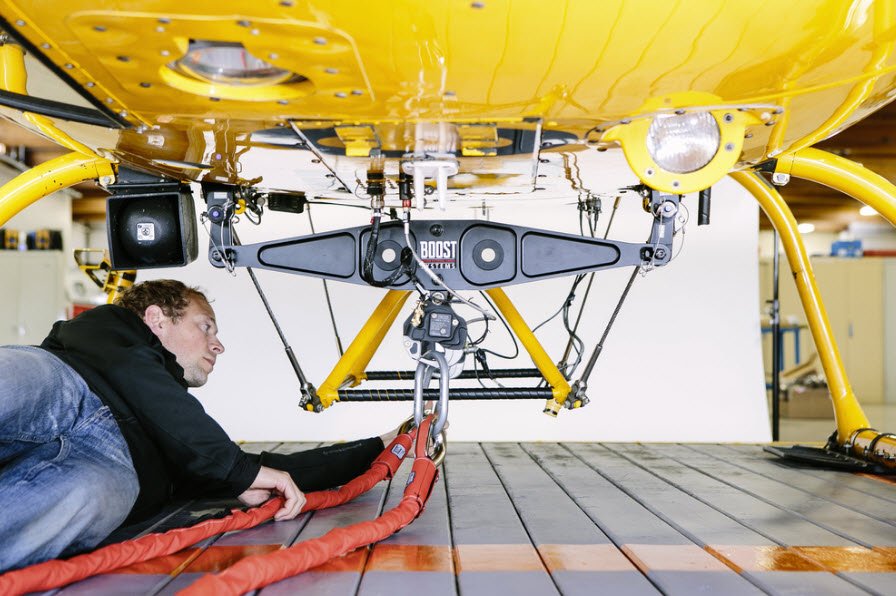
Boost System’s Human External Cargo (HEC) system attaches to the belly of a helicopter. Photo: Boost Systems
Talon has adopted the quick-connect dual-hook Human External Cargo (HEC) kit from Boost Human External Cargo Systems, which can lift five people, or up to 1,100 pounds, on a long-line beneath the helicopter. “It doubles the capacity of our old system,” said Wheeler.
Pilots joining Talon can’t expect to qualify for long-line missions until they have over a year’s worth of experience with SAR transport flights, and gain extensive knowledge of the local terrain. And even then, some Class D rescues can induce a high level of “pucker factor” for pilots.
“There was a rescue, and when we found the subject we wondered, ‘How did he get there?’” recalled Wheeler. “He was perched on a very small ledge. He had fallen and slid, and if he took one more step, he was dead. I had to figure out how to get the NSR guys in, and we used a 250-foot long-line.”
Knowledge of the North Shore Mountains and back-country extends to a deep understanding of the weather, and the microclimates that exist around the region.
“We look at the weather differently. It might be socked in at YVR, but you go up Indian Arm and the cloud layer is lifting. You can’t see it from YVR. You don’t know unless you go,” said Murray. When the forecast for YVR is poor, Talon will pre-position a helicopter on the North Shore for quick response.
Over the years, both NSR and Talon have received many awards and accolades for their work, not to mention heartfelt thanks from the people they have rescued. Danks recalls one challenging rescue in 2008 that led to NSR’s Tim Jones and Gord Ferguson, along with Talon’s Peter Murray, being awarded an RCMP Special Officer-in-Charge Commendation.
“A man was hiking and took a significant fall, about 150 feet, sliding down an ice slope, banging into trees,” said Danks. “They were fortunate to have a cell signal, and his hiking partner was able to make a phone call right at twilight. They didn’t know where they were, but they described what they saw, and Tim Jones said, ‘You’re at Theta Lake.’ ”
Peter Murray lifted off from YVR, just minutes before sunset. “We’ve got one chance, and the layer was high enough, but we were 30 feet above the treetops,” said Murray. “We could see, and it was safe. We saw the guy on the slope, and there was one little tree sticking up in the featureless bowl at the bottom.”
Murray quickly dropped the team off, and returned to YVR. But the weather closed in for the next two days, forcing the NSR team to dig a snow cave for shelter, while treating the hiker’s injuries. After dealing with heavy snowfall and avalanches, the weather cleared barely enough for Murray to return.
“I sort of poked around and couldn’t get into the valley,” recalled Murray. “For me, it’s simple, I don’t actually feel any pressure to do anything but what’s safe. If I can’t get in here, I’ll go over there! Then the cloud lifted, and I went in, but I went out again just to confirm I could get out right away.”
“Peter pulled off a miracle,” said Danks. “The team threw the injured hiker into the backseat and we were out of there. This flight saved the man’s life.”
Saving lives is what North Shore Rescue and Talon Helicopters keep training for, week in and week out, all year long. And the most welcome sight that a stranded hiker could ever see is one of Talon’s bright yellow helicopters hovering overhead, with the team from NSR on a long-line, dropping in to help.
HOW TO GET RESCUED
Make a trip plan – like a flight itinerary, leave it with someone who will call 911 if you’re overdue.
Always carry the 10 essentials – including water, a signalling device and a flashlight.
Never hike alone.
Prepare for your chosen hike – physically, mentally, and with the right equipment.
If you become lost, don’t panic.
Don’t follow downhill terrain – it may lead to ravines, cliffs or waterfalls.
Use signalling devices – blow a whistle or light a fire.
Build or seek shelter.
It could happen to you – be prepared!
